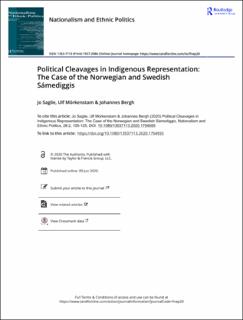| dc.contributor.author | Saglie, Jo | |
| dc.contributor.author | Mörkenstam, Ulf | |
| dc.contributor.author | Bergh, Johannes | |
| dc.date.accessioned | 2020-06-11T05:40:58Z | |
| dc.date.available | 2020-06-11T05:40:58Z | |
| dc.date.created | 2020-06-10T17:45:22Z | |
| dc.date.issued | 2020 | |
| dc.identifier.citation | Nationalism & Ethnic Politics. 2020, 26 (2), 105-125. | |
| dc.identifier.issn | 1353-7113 | |
| dc.identifier.uri | https://hdl.handle.net/11250/2657622 | |
| dc.description.abstract | Using Lipset and Rokkan’s cleavage theory in an Indigenous context, the article compares political cleavages in internal Sámi politics in Norway and Sweden. The authors discuss the historical legacies of each country’s policies toward the Sámi and subsequent development of party systems before using survey data to analyze cleavages within the Sámi electorates. The analysis shows a prominent cleavage in Sámi politics in Norway regarding the extent of Sámi self-determination, whereas the main cleavage in Sweden can be found in the category-split between reindeer herders and other Sámi created by state policy. Contemporary cleavages in Indigenous politics may, thus, be deeply rooted in nation-building processes. | |
| dc.language.iso | eng | |
| dc.relation.uri | https://www.tandfonline.com/doi/full/10.1080/13537113.2020.1754555 | |
| dc.title | Political Cleavages in Indigenous Representation: The Case of the Norwegian and Swedish Sámediggis | |
| dc.type | Peer reviewed | |
| dc.type | Journal article | |
| dc.description.version | publishedVersion | |
| dc.source.pagenumber | 105-125 | |
| dc.source.volume | 26 | |
| dc.source.journal | Nationalism & Ethnic Politics | |
| dc.source.issue | 2 | |
| dc.identifier.doi | 10.1080/13537113.2020.1754555 | |
| dc.identifier.cristin | 1814881 | |
| dc.relation.project | Norges forskningsråd: 259421 | |
| cristin.ispublished | true | |
| cristin.fulltext | original | |
| cristin.qualitycode | 1 | |
